

Sitting Bull's Great Grandson Tells Oral History Film Clip. Crazy Horse's Account of the Battle of the Little Bighorn. Untold Stories Of The Second World War: The Navajo (Part 3) Untold Stories Of The Second World War: The Navajo (Part 2) Untold Stories Of The Second World War: The Navajo(Part 1) Russell Means: Welcome To The Reservation. A Warrior in Two Worlds. The Thomas Legion. William Holland Thomas, state legislator and “white chief” of the Cherokee, was 56 years old when the Civil War began.
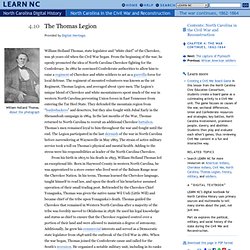
From the beginning of the war, he openly promoted the idea of North Carolina Cherokee fighting for the Confederacy. In 1862 he convinced Confederate authorities to allow him to raise a regiment of Cherokee and white soldiers to act as a guerrilla force for local defense. The regiment of mounted volunteers was known as the 1st Regiment, Thomas Legion, and averaged about 1500 men.
The Legion’s unique blend of Cherokee and white mountaineers spent much of the war in western North Carolina preventing Union forces in East Tennessee from entering the Tar Heel State. They defended the mountain region from “bushwhackers” and deserters, but they also fought with Jubal Early in the Shenandoah campaign in 1864. From his birth in 1805 to his death in 1893, William Holland Thomas led an exceptional life. Tensions between the North and South finally erupted into war in April, 1861. Indian-Pioneer Papers Collection. Black Hawk War of 1832. By James Lewis, Ph.D.
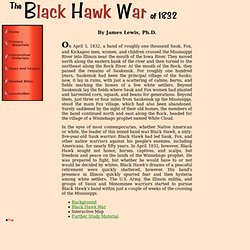
Indian removal. Early in the 19th century, while the rapidly-growing United States expanded into the lower South, white settlers faced what they considered an obstacle.
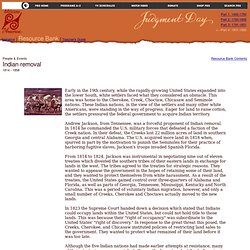
This area was home to the Cherokee, Creek, Choctaw, Chicasaw and Seminole nations. These Indian nations, in the view of the settlers and many other white Americans, were standing in the way of progress. Eager for land to raise cotton, the settlers pressured the federal government to acquire Indian territory. Andrew Jackson, from Tennessee, was a forceful proponent of Indian removal. In 1814 he commanded the U.S. military forces that defeated a faction of the Creek nation. From 1814 to 1824, Jackson was instrumental in negotiating nine out of eleven treaties which divested the southern tribes of their eastern lands in exchange for lands in the west. In 1823 the Supreme Court handed down a decision which stated that Indians could occupy lands within the United States, but could not hold title to those lands.
Previous | next. Tecumseh - Ohio History Central - A product of the Ohio Historical Society. Tecumseh, meaning Shooting Star, was born in 1768 near Chillicothe, Ohio to the Shawnee tribe; specifically he was the son of the reigning Chief, Pukeshinwau.
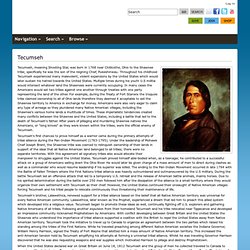
Throughout his childhood Tecumseh experienced many malevolent, violent expansions by the United States which would later sustain his hatred towards the United States. Multiple times during his youth U.S militia would intersect whatever land the Shawnees were currently occupying. In many cases the Americans would set two tribes against one another through treaties with one party representing the land of the other. For example, during the Treaty of Fort Stanwix the Iroquois tribe claimed ownership to all of Ohio lands therefore they deemed it acceptable to sell the Shawnee territory to America in exchange for money.
Americans were also very eager to claim any type of acreage so they plundered many Native American villages, including the Shawnee's various home lands a multitude of times. See Also References. Abama Department of Archives and History, Using Primary Sources in the Classroom: Creek Indian War, 1813-1814 Unit. In the early part of the sixteenth century, white explorers who visited the territory now forming the southeastern United States found it occupied by tribes of American Indians who had lived there for centuries. The Creek, Cherokee, Seminole, Chickasaw, and Choctaw Indians saw the land they inhabited become an object of desire for the visitors.
Inevitably, this interest in the southeastern Indian land caused contention, conflict, and the eventual forced removal of the tribes to Indian Territory in what is now Oklahoma. As white settlers began to move into the region at the start of the nineteenth century, the Creeks became increasingly hostile. Many did not wish to adopt the ways of whites as government agents urged them to do under a new Indian policy instituted by President George Washington.
Indian agents were supposed to instruct Indians how to plow, raise cotton, weave, spin, care for domestic animals, and become skilled in carpentry or black smithing. 1. 2. 1. 2. Thomas Jefferson and American Indians. Lewis and Clark . Native Americans. While Lewis and Clark were the first Americans to see much of what would become the western United States, those same lands had long been occupied by native peoples.

Over the course of the expedition, the Corps of Discovery would come into contact with nearly 50 Native American tribes. Quickly, the captains learned how many different definitions there really were for the word “Indian.” The Mandans lived in earth lodges, farmed corn and were amenable to trade with America. The Teton Sioux slept in tepees, hunted buffalo and guarded their territory fiercely against anyone who passed through, whether foreign or Indian. Some tribes had never seen a white or black man before Lewis and Clark. President Jefferson and the Indian Nations. Rivers, Edens, Empires: Lewis&Clark and the Revealing of America (Library of Congress Exhibition)
"The Print of My Ancestors' Houses are Every Where to be Seen": Little Turtle Balks at Giving Up Land to General Anthony Wayne, 1795. Battle of Fallen Timbers - Ohio History Central - A product of the Ohio Historical Society. The Battle of Fallen Timbers was an important victory for the United States Army against natives in the Northwest Territory.
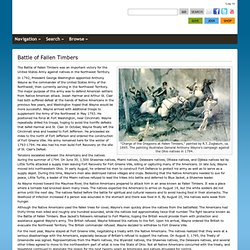
In 1792, President George Washington appointed Anthony Wayne as the commander of the United States Army of the Northwest, then currently serving in the Northwest Territory. The major purpose of this army was to defend American settlers from Native American attack. Josiah Harmar and Arthur St. Clair had both suffered defeat at the hands of Native Americans in the previous few years, and Washington hoped that Wayne would be more successful. The War for Independence Through Seneca Eyes: Mary Jemison Views the Revolution, 1775-79. The American Revolution divided Indian communities as well as Euro-American ones.
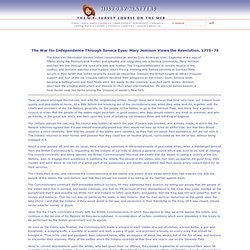
Captured at the age of fifteen along the Pennsylvania frontier and adopted and integrated into a Seneca community, Mary Jemison watched the war through the eyes of a wife and mother. The Iroquois attempted to remain neutral in the conflict, and Jemison watched tribal leaders return from a meeting with Patriot colonists at German Flats, secure in their belief that Indian neutrality would be respected. Instead, the British sought to attract Iroquois support and four of the six Iroquois nations declared their allegiance to the crown. Soon, Seneca lands became a battleground and their fields were laid waste by the colonists’ scorched earth tactics. Jemison described the ensuing destruction and disease in 1823 when she related her life story to James Seaver, a local doctor near her home among the Iroquois of western New York. "Brother, you have merited death! "Brother!
Northwest Ordinance: Primary Documents of American History (Virtual Programs & Services, Library of Congress) The American Revolution. American Indians and the American Revolution by Collin G.
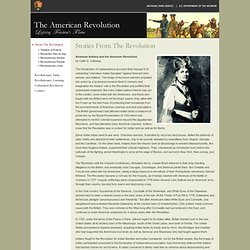
Calloway. Pontiac's Rebellion - Ohio History Central - A product of the Ohio Historical Society. In 1763, the Treaty of Paris brought the French and Indian War to a close.
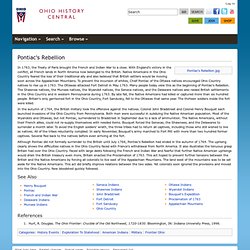
With England's victory in the conflict, all French lands in North America now belonged to the British. Native Americans in the Ohio Country feared the loss of their traditional ally and also believed that British settlers would be moving soon across the Appalachian Mountains. To prevent the incursion of whites, Chief Pontiac of the Ottawa natives encouraged Ohio Country natives to rise up in 1763. The Ottawas attacked Fort Detroit in May 1763. Many people today view this as the beginning of Pontiac's Rebellion. The War That Made America : In the Classroom. Captured By Indians: Mary Jemison Becomes an Indian. By Mary Jemison In 1753, fifteen year old Mary Jemison was captured by Indians along the Pennsylvania frontier during the Seven Years’ War between the French, English, and Indian peoples of North America.
She was adopted and incorporated into the Senecas, a familiar practice among Iroquois and other Indian peoples seeking to replace a lost sibling or spouse. Mary married and raised a family in the decades before and after the American Revolution; many captives, once adopted and integrated into an Indian community, refused the opportunity to return home, finding life in Indian society more rewarding. In 1823 Mary Jemison related her life story to James Seaver, a doctor who lived near her home in western New York. Seaver’s story of “the white woman of the Genessee,” as she became known, sold over 100,000 copies in 1824. I had been in that situation hut a few minutes, before all the squaws in the town came in to see me. “Oh our brother! Source: James E. Maps of the French and Indian War - Home. "Another Race of White Men Come Amongst Us": Native American Views as British Replace the French in the Lower Mississippi Valley, 1765.
Because most early-eighteenth century European colonization occurred in coastal areas, Native Americans living in interior regions maintained greater control over their lands and culture.